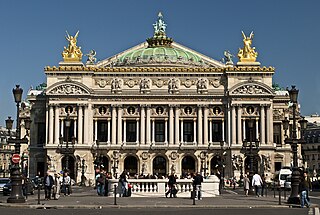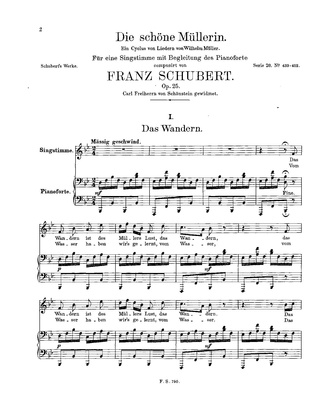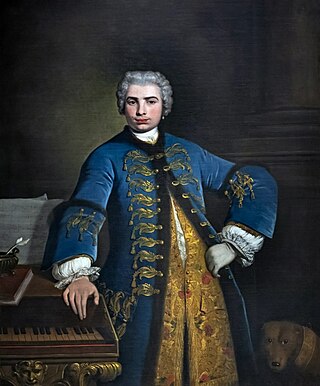Related Research Articles

Opera is a form of theatre in which music is a fundamental component and dramatic roles are taken by singers. Such a "work" is typically a collaboration between a composer and a librettist and incorporates a number of the performing arts, such as acting, scenery, costume, and sometimes dance or ballet. The performance is typically given in an opera house, accompanied by an orchestra or smaller musical ensemble, which since the early 19th century has been led by a conductor. Although musical theatre is closely related to opera, the two are considered to be distinct from one another.

Wilhelm Richard Wagner was a German composer, theatre director, polemicist, and conductor who is chiefly known for his operas. Unlike most opera composers, Wagner wrote both the libretto and the music for each of his stage works. Initially establishing his reputation as a composer of works in the romantic vein of Carl Maria von Weber and Giacomo Meyerbeer, Wagner revolutionised opera through his concept of the Gesamtkunstwerk, by which he sought to synthesise the poetic, visual, musical and dramatic arts, with music subsidiary to drama. He described this vision in a series of essays published between 1849 and 1852. Wagner realised these ideas most fully in the first half of the four-opera cycle Der Ring des Nibelungen.
A symphonic poem or tone poem is a piece of orchestral music, usually in a single continuous movement, which illustrates or evokes the content of a poem, short story, novel, painting, landscape, or other (non-musical) source. The German term Tondichtung appears to have been first used by the composer Carl Loewe in 1828. The Hungarian composer Franz Liszt first applied the term Symphonische Dichtung to his 13 works in this vein.
In music, an ostinato is a motif or phrase that persistently repeats in the same musical voice, frequently in the same pitch. Well-known ostinato-based pieces include classical compositions such as Ravel's Boléro and the Carol of the Bells, and popular songs such as Donna Summer and Giorgio Moroder's "I Feel Love" (1977), Henry Mancini's theme from Peter Gunn (1959), The Who's "Baba O'Riley" (1971), and The Verve's "Bitter Sweet Symphony" (1997).
The rondo is a musical form that contains a principal theme which alternates with one or more contrasting themes, generally called "episodes", but also occasionally referred to as "digressions" or "couplets". Some possible patterns include: ABACA, ABACAB, ABACBA, or ABACABA.

Strophic form – also called verse-repeating form, chorus form, AAA song form, or one-part song form – is a song structure in which all verses or stanzas of the text are sung to the same music. Contrasting song forms include through-composed, with new music written for every stanza, and ternary form, with a contrasting central section.
The Tristan chord is a chord made up of the notes F, B, D♯, and G♯:
Literally "song" in Italian, a canzone is an Italian or Provençal song or ballad. It is also used to describe a type of lyric which resembles a madrigal. Sometimes a composition which is simple and songlike is designated as a canzone, especially if it is by a non-Italian; a good example is the aria "Voi che sapete" from Mozart's Marriage of Figaro.

Coloratura is an elaborate melody with runs, trills, wide leaps, or similar virtuoso-like material, or a passage of such music. Operatic roles in which such music plays a prominent part, and singers of these roles, are also called coloratura. Its instrumental equivalent is ornamentation.
The canzona is an Italian musical form derived from the Franco-Flemish and Parisian chansons, and during Giovanni Gabrieli's lifetime was frequently spelled canzona, though both earlier and later the singular was spelled either canzon or canzone with the plural canzoni. The use of canzone as the plural is sometimes found in Italian, but is not common. English uses the form canzona, with canzonas as the plural.
In music, a canzonetta is a popular Italian secular vocal composition that originated around 1560. Earlier versions were somewhat like a madrigal but lighter in style—but by the 18th century, especially as it moved outside of Italy, the term came to mean a song for voice and accompaniment, usually in a light secular style.

A fermata is a symbol of musical notation indicating that the note should be prolonged beyond the normal duration its note value would indicate. Exactly how much longer it is held is up to the discretion of the performer or conductor, but twice as long is common. It is usually printed above but can be occasionally below the note to be extended.
In music, especially Western popular music, a bridge is a contrasting section that prepares for the return of the original material section. In a piece in which the original material or melody is referred to as the "A" section, the bridge may be the third eight-bar phrase in a thirty-two-bar form, or may be used more loosely in verse-chorus form, or, in a compound AABA form, used as a contrast to a full AABA section.
Parody music, or musical parody, involves changing or copying existing musical ideas, and/or lyrics, or copying the particular style of a composer or performer, or even a general style of music.
Bar form is a musical form of the pattern AAB.

Max Lorenz was a German heldentenor famous for Wagnerian roles.

The Royal Naval College, Osborne, was a training college for Royal Navy officer cadets on the Osborne House estate, Isle of Wight, established in 1903 and closed in 1921.
A bass is a type of classical male singing voice and has the lowest vocal range of all voice types. According to The New Grove Dictionary of Opera, a bass is typically classified as having a vocal range extending from around the second E below middle C to the E above middle C (i.e., E2–E4). Its tessitura, or comfortable range, is normally defined by the outermost lines of the bass clef. Categories of bass voices vary according to national style and classification system.
Alfred Ottokar Lorenz was an Austrian-German conductor, composer, and musical analyst. His principal work is the four-volume Das Geheimnis der Form bei Richard Wagner, which attempts to comprehensively analyze some of Richard Wagner's best-known operas. Lorenz's work reflects to a great extent his sympathy with Nazi ideology, and has only recently been discredited by scholarship.
References
- ↑ Horst Brunner (2000). Stanley Sadie (ed.). New Grove Dictionary of Music and Musicians. Oxford: Oxford University Press.
- ↑ The New Harvard Dictionary of Music . Harvard: Belknap. 1986. p. 721. ISBN 9780674615250.
- ↑ Lorenz, A. (1924). Das Geheimis der Form bei Richard Wagner. Berlin.